Metro Dental Services Employee Engagement Survey Analysis - 2015
VerifiedAdded on 2023/04/08
|9
|1708
|433
Report
AI Summary
This report analyzes the 2015 employee engagement survey results from Metro Dental Services, identifying both weaknesses and strengths within the organization. The weaknesses include excessive work demands, management system issues, lack of participation and recognition, limited advancement opportunities, and dissatisfaction with pay and benefits. The strengths encompass positive working conditions, strong teamwork, ample training opportunities, and employee empowerment. The analysis explores the impact of these factors on employee engagement and proposes plans to improve low engagement scores through recruitment, management training, recognition programs, and enhanced benefits. Conversely, it suggests celebrating high engagement scores by further developing organizational culture, promoting teamwork through social activities, and providing more advanced training opportunities. The report concludes that regular employee engagement surveys are crucial for understanding and addressing workplace dynamics to improve employee motivation and productivity.
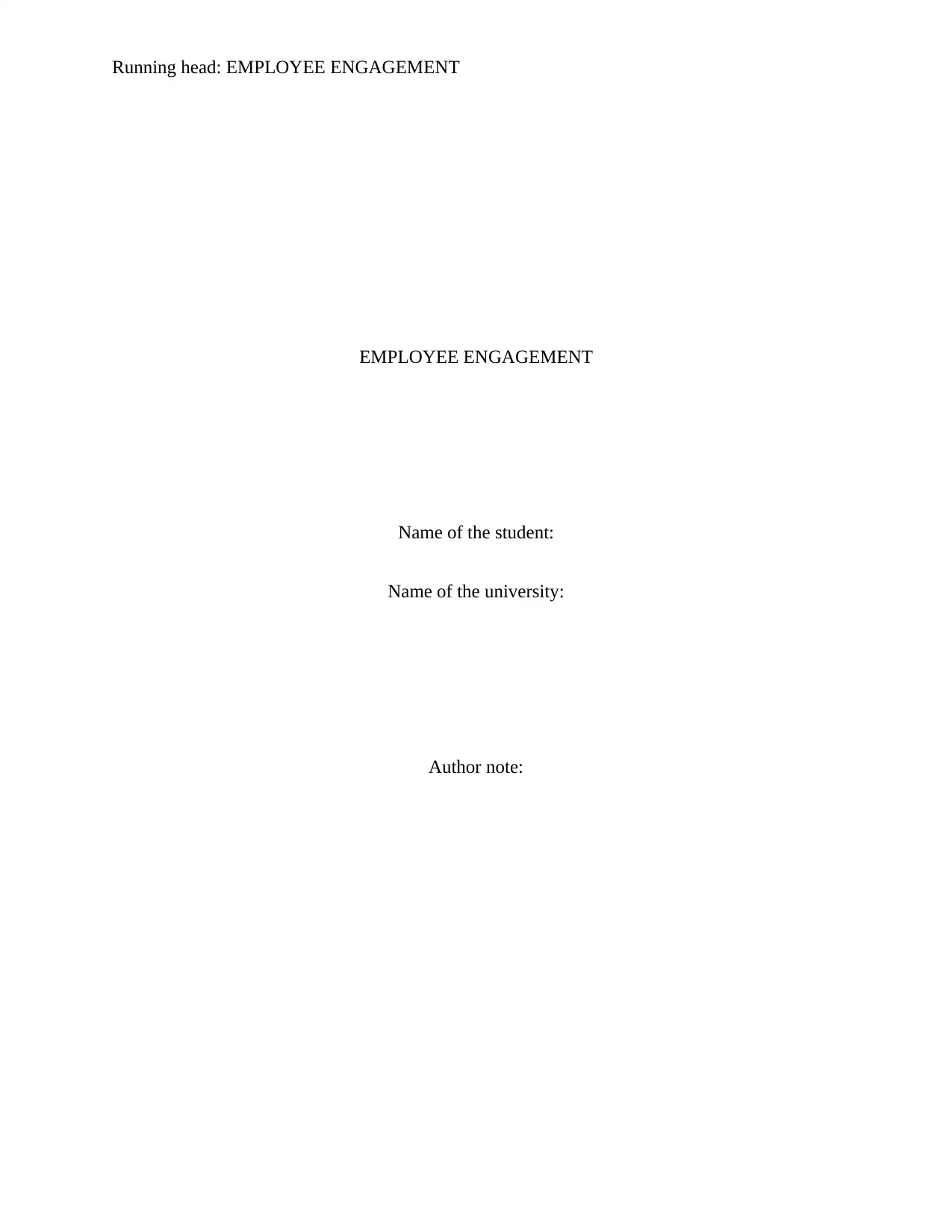
Running head: EMPLOYEE ENGAGEMENT
EMPLOYEE ENGAGEMENT
Name of the student:
Name of the university:
Author note:
EMPLOYEE ENGAGEMENT
Name of the student:
Name of the university:
Author note:
Secure Best Marks with AI Grader
Need help grading? Try our AI Grader for instant feedback on your assignments.
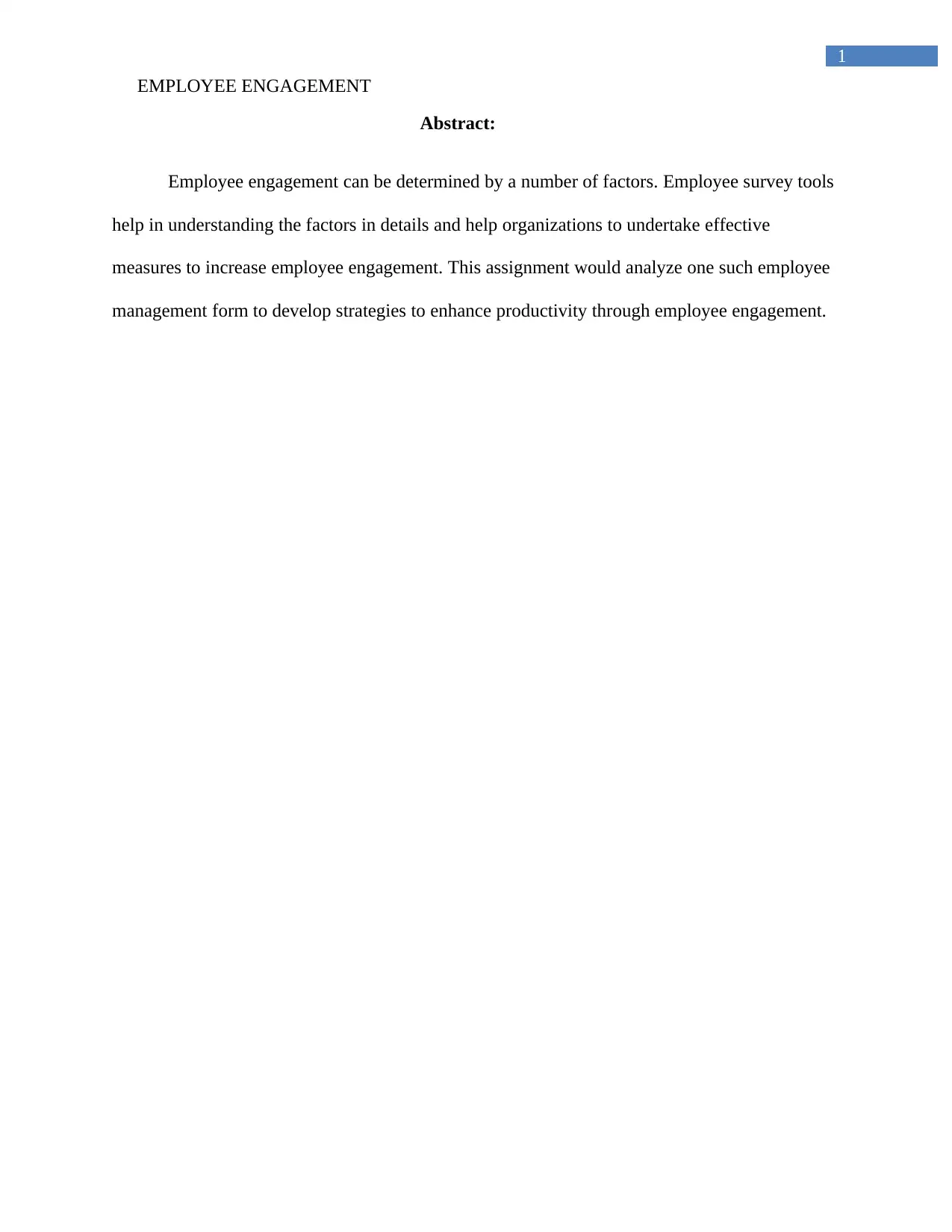
1
EMPLOYEE ENGAGEMENT
Abstract:
Employee engagement can be determined by a number of factors. Employee survey tools
help in understanding the factors in details and help organizations to undertake effective
measures to increase employee engagement. This assignment would analyze one such employee
management form to develop strategies to enhance productivity through employee engagement.
EMPLOYEE ENGAGEMENT
Abstract:
Employee engagement can be determined by a number of factors. Employee survey tools
help in understanding the factors in details and help organizations to undertake effective
measures to increase employee engagement. This assignment would analyze one such employee
management form to develop strategies to enhance productivity through employee engagement.
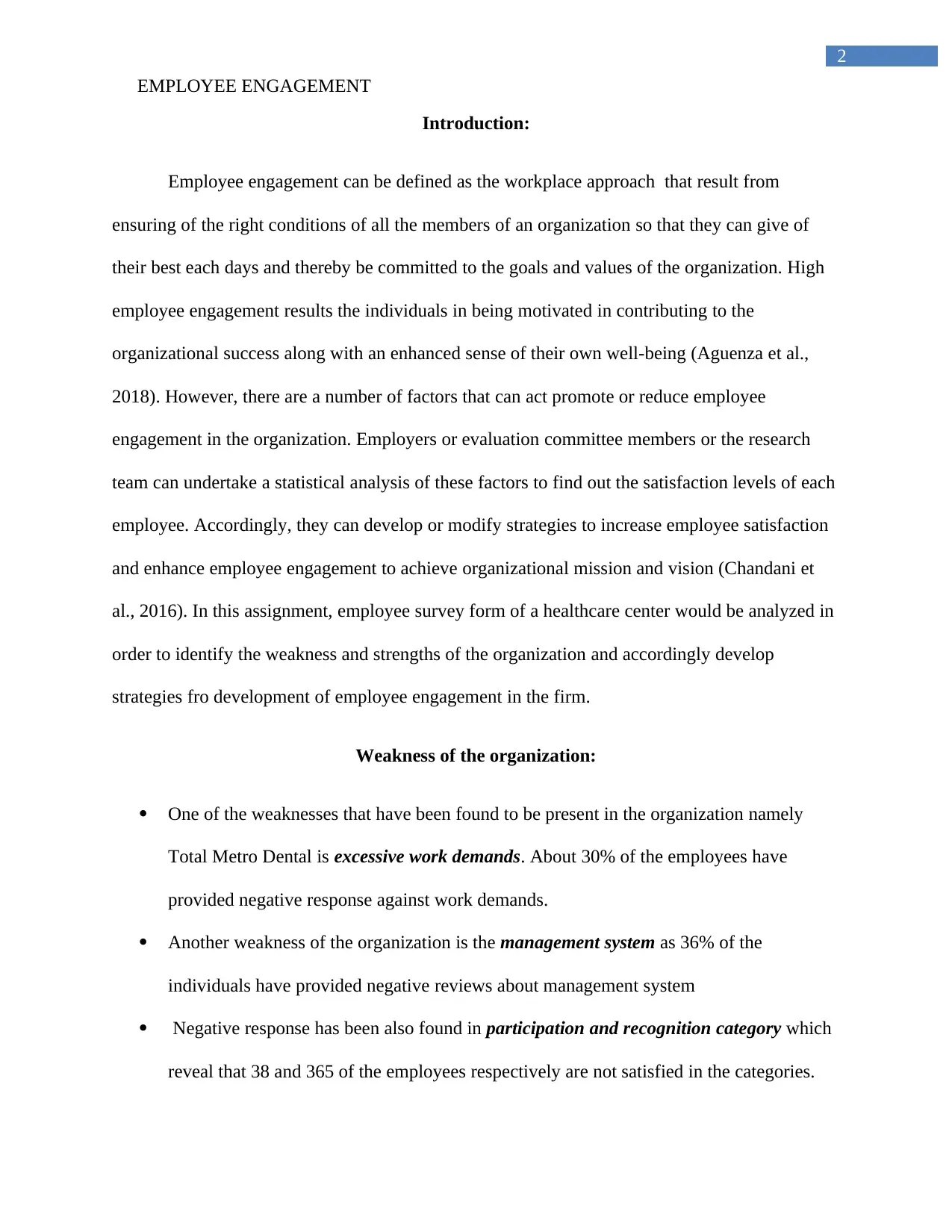
2
EMPLOYEE ENGAGEMENT
Introduction:
Employee engagement can be defined as the workplace approach that result from
ensuring of the right conditions of all the members of an organization so that they can give of
their best each days and thereby be committed to the goals and values of the organization. High
employee engagement results the individuals in being motivated in contributing to the
organizational success along with an enhanced sense of their own well-being (Aguenza et al.,
2018). However, there are a number of factors that can act promote or reduce employee
engagement in the organization. Employers or evaluation committee members or the research
team can undertake a statistical analysis of these factors to find out the satisfaction levels of each
employee. Accordingly, they can develop or modify strategies to increase employee satisfaction
and enhance employee engagement to achieve organizational mission and vision (Chandani et
al., 2016). In this assignment, employee survey form of a healthcare center would be analyzed in
order to identify the weakness and strengths of the organization and accordingly develop
strategies fro development of employee engagement in the firm.
Weakness of the organization:
One of the weaknesses that have been found to be present in the organization namely
Total Metro Dental is excessive work demands. About 30% of the employees have
provided negative response against work demands.
Another weakness of the organization is the management system as 36% of the
individuals have provided negative reviews about management system
Negative response has been also found in participation and recognition category which
reveal that 38 and 365 of the employees respectively are not satisfied in the categories.
EMPLOYEE ENGAGEMENT
Introduction:
Employee engagement can be defined as the workplace approach that result from
ensuring of the right conditions of all the members of an organization so that they can give of
their best each days and thereby be committed to the goals and values of the organization. High
employee engagement results the individuals in being motivated in contributing to the
organizational success along with an enhanced sense of their own well-being (Aguenza et al.,
2018). However, there are a number of factors that can act promote or reduce employee
engagement in the organization. Employers or evaluation committee members or the research
team can undertake a statistical analysis of these factors to find out the satisfaction levels of each
employee. Accordingly, they can develop or modify strategies to increase employee satisfaction
and enhance employee engagement to achieve organizational mission and vision (Chandani et
al., 2016). In this assignment, employee survey form of a healthcare center would be analyzed in
order to identify the weakness and strengths of the organization and accordingly develop
strategies fro development of employee engagement in the firm.
Weakness of the organization:
One of the weaknesses that have been found to be present in the organization namely
Total Metro Dental is excessive work demands. About 30% of the employees have
provided negative response against work demands.
Another weakness of the organization is the management system as 36% of the
individuals have provided negative reviews about management system
Negative response has been also found in participation and recognition category which
reveal that 38 and 365 of the employees respectively are not satisfied in the categories.
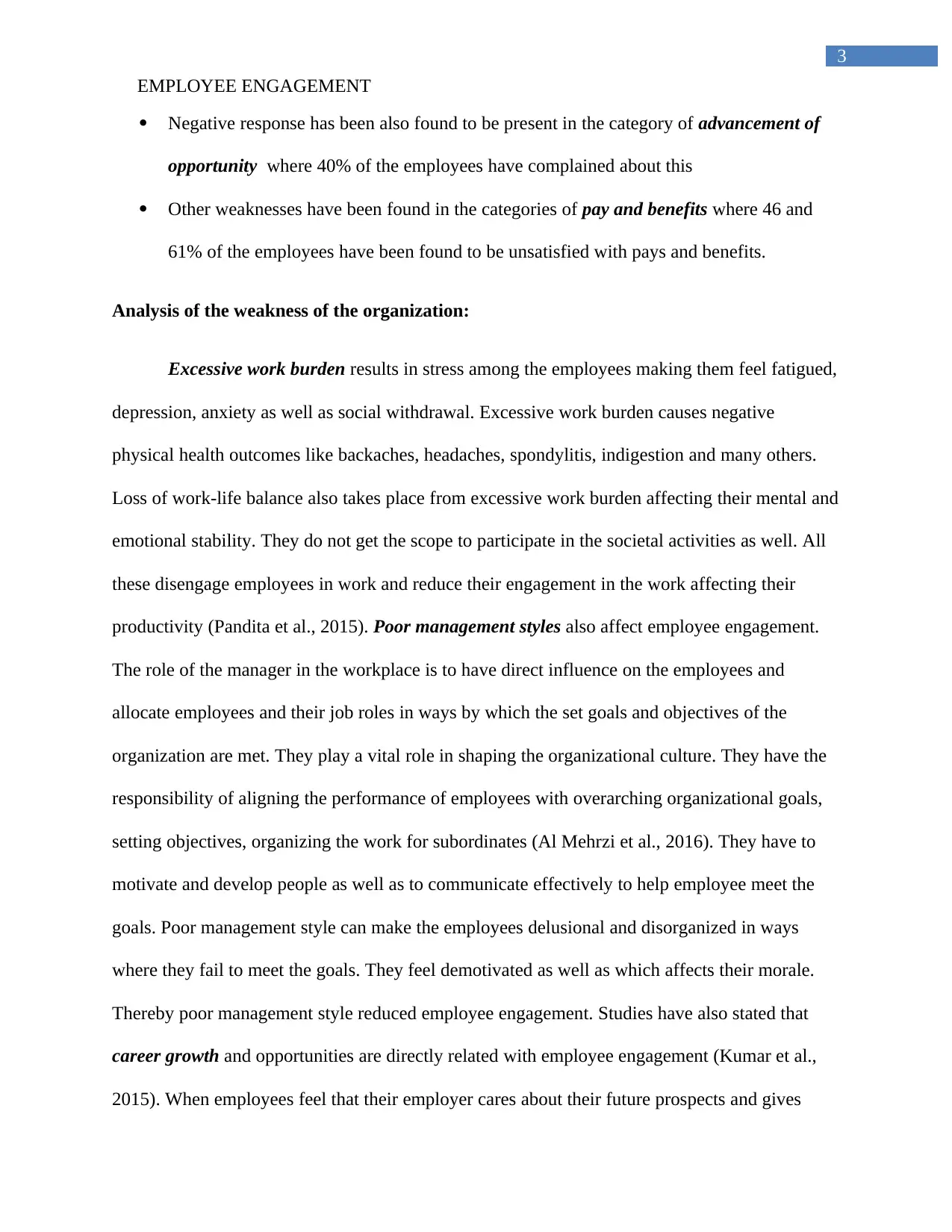
3
EMPLOYEE ENGAGEMENT
Negative response has been also found to be present in the category of advancement of
opportunity where 40% of the employees have complained about this
Other weaknesses have been found in the categories of pay and benefits where 46 and
61% of the employees have been found to be unsatisfied with pays and benefits.
Analysis of the weakness of the organization:
Excessive work burden results in stress among the employees making them feel fatigued,
depression, anxiety as well as social withdrawal. Excessive work burden causes negative
physical health outcomes like backaches, headaches, spondylitis, indigestion and many others.
Loss of work-life balance also takes place from excessive work burden affecting their mental and
emotional stability. They do not get the scope to participate in the societal activities as well. All
these disengage employees in work and reduce their engagement in the work affecting their
productivity (Pandita et al., 2015). Poor management styles also affect employee engagement.
The role of the manager in the workplace is to have direct influence on the employees and
allocate employees and their job roles in ways by which the set goals and objectives of the
organization are met. They play a vital role in shaping the organizational culture. They have the
responsibility of aligning the performance of employees with overarching organizational goals,
setting objectives, organizing the work for subordinates (Al Mehrzi et al., 2016). They have to
motivate and develop people as well as to communicate effectively to help employee meet the
goals. Poor management style can make the employees delusional and disorganized in ways
where they fail to meet the goals. They feel demotivated as well as which affects their morale.
Thereby poor management style reduced employee engagement. Studies have also stated that
career growth and opportunities are directly related with employee engagement (Kumar et al.,
2015). When employees feel that their employer cares about their future prospects and gives
EMPLOYEE ENGAGEMENT
Negative response has been also found to be present in the category of advancement of
opportunity where 40% of the employees have complained about this
Other weaknesses have been found in the categories of pay and benefits where 46 and
61% of the employees have been found to be unsatisfied with pays and benefits.
Analysis of the weakness of the organization:
Excessive work burden results in stress among the employees making them feel fatigued,
depression, anxiety as well as social withdrawal. Excessive work burden causes negative
physical health outcomes like backaches, headaches, spondylitis, indigestion and many others.
Loss of work-life balance also takes place from excessive work burden affecting their mental and
emotional stability. They do not get the scope to participate in the societal activities as well. All
these disengage employees in work and reduce their engagement in the work affecting their
productivity (Pandita et al., 2015). Poor management styles also affect employee engagement.
The role of the manager in the workplace is to have direct influence on the employees and
allocate employees and their job roles in ways by which the set goals and objectives of the
organization are met. They play a vital role in shaping the organizational culture. They have the
responsibility of aligning the performance of employees with overarching organizational goals,
setting objectives, organizing the work for subordinates (Al Mehrzi et al., 2016). They have to
motivate and develop people as well as to communicate effectively to help employee meet the
goals. Poor management style can make the employees delusional and disorganized in ways
where they fail to meet the goals. They feel demotivated as well as which affects their morale.
Thereby poor management style reduced employee engagement. Studies have also stated that
career growth and opportunities are directly related with employee engagement (Kumar et al.,
2015). When employees feel that their employer cares about their future prospects and gives
Secure Best Marks with AI Grader
Need help grading? Try our AI Grader for instant feedback on your assignments.
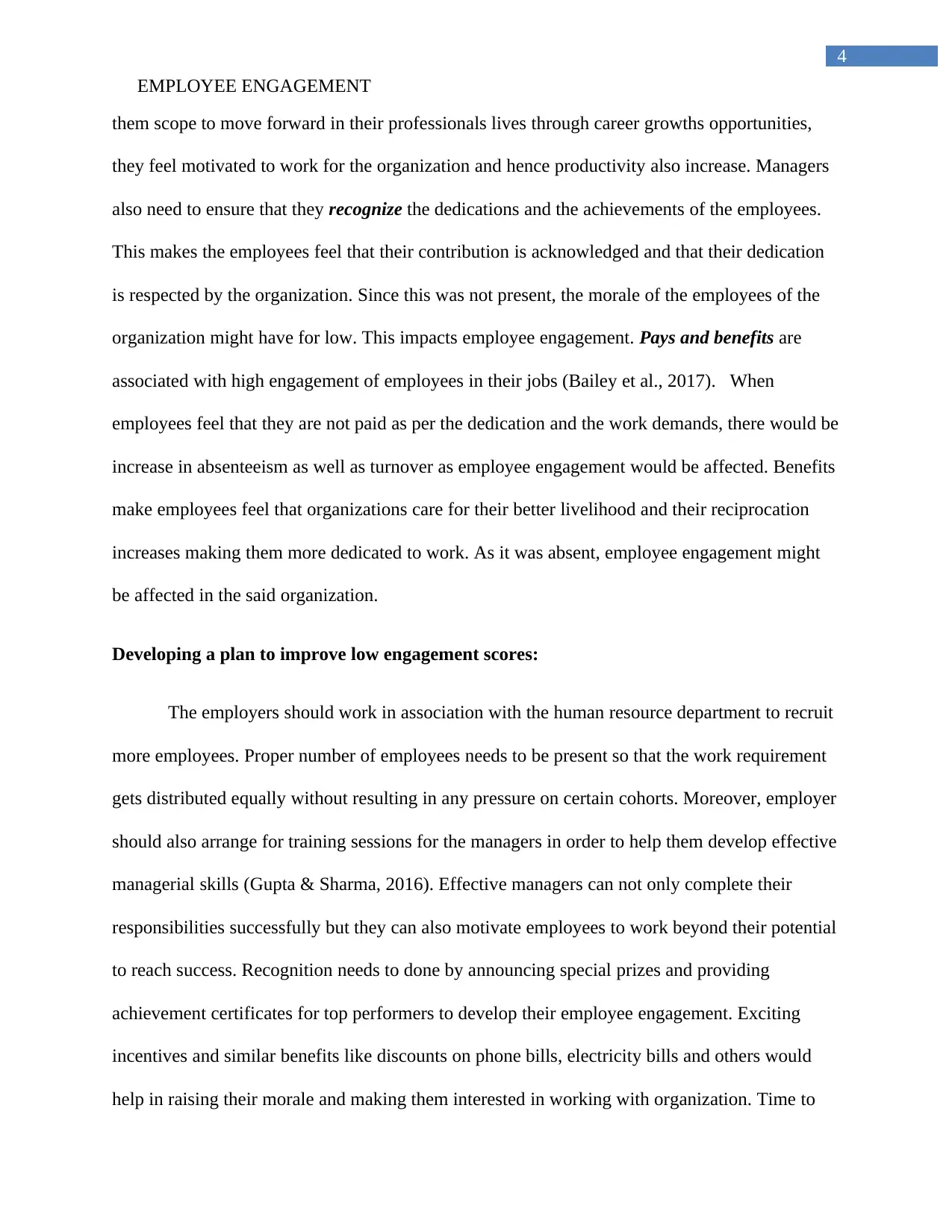
4
EMPLOYEE ENGAGEMENT
them scope to move forward in their professionals lives through career growths opportunities,
they feel motivated to work for the organization and hence productivity also increase. Managers
also need to ensure that they recognize the dedications and the achievements of the employees.
This makes the employees feel that their contribution is acknowledged and that their dedication
is respected by the organization. Since this was not present, the morale of the employees of the
organization might have for low. This impacts employee engagement. Pays and benefits are
associated with high engagement of employees in their jobs (Bailey et al., 2017). When
employees feel that they are not paid as per the dedication and the work demands, there would be
increase in absenteeism as well as turnover as employee engagement would be affected. Benefits
make employees feel that organizations care for their better livelihood and their reciprocation
increases making them more dedicated to work. As it was absent, employee engagement might
be affected in the said organization.
Developing a plan to improve low engagement scores:
The employers should work in association with the human resource department to recruit
more employees. Proper number of employees needs to be present so that the work requirement
gets distributed equally without resulting in any pressure on certain cohorts. Moreover, employer
should also arrange for training sessions for the managers in order to help them develop effective
managerial skills (Gupta & Sharma, 2016). Effective managers can not only complete their
responsibilities successfully but they can also motivate employees to work beyond their potential
to reach success. Recognition needs to done by announcing special prizes and providing
achievement certificates for top performers to develop their employee engagement. Exciting
incentives and similar benefits like discounts on phone bills, electricity bills and others would
help in raising their morale and making them interested in working with organization. Time to
EMPLOYEE ENGAGEMENT
them scope to move forward in their professionals lives through career growths opportunities,
they feel motivated to work for the organization and hence productivity also increase. Managers
also need to ensure that they recognize the dedications and the achievements of the employees.
This makes the employees feel that their contribution is acknowledged and that their dedication
is respected by the organization. Since this was not present, the morale of the employees of the
organization might have for low. This impacts employee engagement. Pays and benefits are
associated with high engagement of employees in their jobs (Bailey et al., 2017). When
employees feel that they are not paid as per the dedication and the work demands, there would be
increase in absenteeism as well as turnover as employee engagement would be affected. Benefits
make employees feel that organizations care for their better livelihood and their reciprocation
increases making them more dedicated to work. As it was absent, employee engagement might
be affected in the said organization.
Developing a plan to improve low engagement scores:
The employers should work in association with the human resource department to recruit
more employees. Proper number of employees needs to be present so that the work requirement
gets distributed equally without resulting in any pressure on certain cohorts. Moreover, employer
should also arrange for training sessions for the managers in order to help them develop effective
managerial skills (Gupta & Sharma, 2016). Effective managers can not only complete their
responsibilities successfully but they can also motivate employees to work beyond their potential
to reach success. Recognition needs to done by announcing special prizes and providing
achievement certificates for top performers to develop their employee engagement. Exciting
incentives and similar benefits like discounts on phone bills, electricity bills and others would
help in raising their morale and making them interested in working with organization. Time to
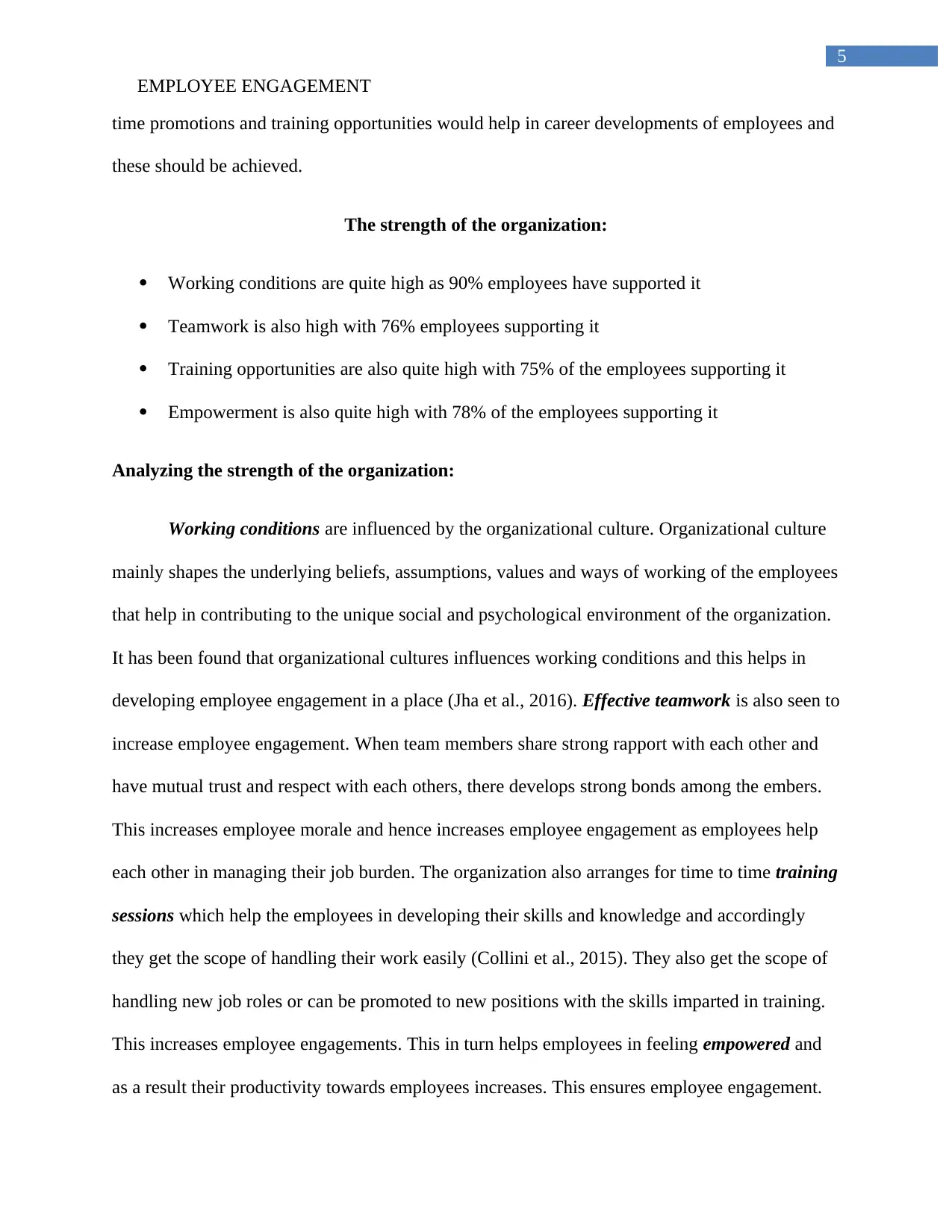
5
EMPLOYEE ENGAGEMENT
time promotions and training opportunities would help in career developments of employees and
these should be achieved.
The strength of the organization:
Working conditions are quite high as 90% employees have supported it
Teamwork is also high with 76% employees supporting it
Training opportunities are also quite high with 75% of the employees supporting it
Empowerment is also quite high with 78% of the employees supporting it
Analyzing the strength of the organization:
Working conditions are influenced by the organizational culture. Organizational culture
mainly shapes the underlying beliefs, assumptions, values and ways of working of the employees
that help in contributing to the unique social and psychological environment of the organization.
It has been found that organizational cultures influences working conditions and this helps in
developing employee engagement in a place (Jha et al., 2016). Effective teamwork is also seen to
increase employee engagement. When team members share strong rapport with each other and
have mutual trust and respect with each others, there develops strong bonds among the embers.
This increases employee morale and hence increases employee engagement as employees help
each other in managing their job burden. The organization also arranges for time to time training
sessions which help the employees in developing their skills and knowledge and accordingly
they get the scope of handling their work easily (Collini et al., 2015). They also get the scope of
handling new job roles or can be promoted to new positions with the skills imparted in training.
This increases employee engagements. This in turn helps employees in feeling empowered and
as a result their productivity towards employees increases. This ensures employee engagement.
EMPLOYEE ENGAGEMENT
time promotions and training opportunities would help in career developments of employees and
these should be achieved.
The strength of the organization:
Working conditions are quite high as 90% employees have supported it
Teamwork is also high with 76% employees supporting it
Training opportunities are also quite high with 75% of the employees supporting it
Empowerment is also quite high with 78% of the employees supporting it
Analyzing the strength of the organization:
Working conditions are influenced by the organizational culture. Organizational culture
mainly shapes the underlying beliefs, assumptions, values and ways of working of the employees
that help in contributing to the unique social and psychological environment of the organization.
It has been found that organizational cultures influences working conditions and this helps in
developing employee engagement in a place (Jha et al., 2016). Effective teamwork is also seen to
increase employee engagement. When team members share strong rapport with each other and
have mutual trust and respect with each others, there develops strong bonds among the embers.
This increases employee morale and hence increases employee engagement as employees help
each other in managing their job burden. The organization also arranges for time to time training
sessions which help the employees in developing their skills and knowledge and accordingly
they get the scope of handling their work easily (Collini et al., 2015). They also get the scope of
handling new job roles or can be promoted to new positions with the skills imparted in training.
This increases employee engagements. This in turn helps employees in feeling empowered and
as a result their productivity towards employees increases. This ensures employee engagement.
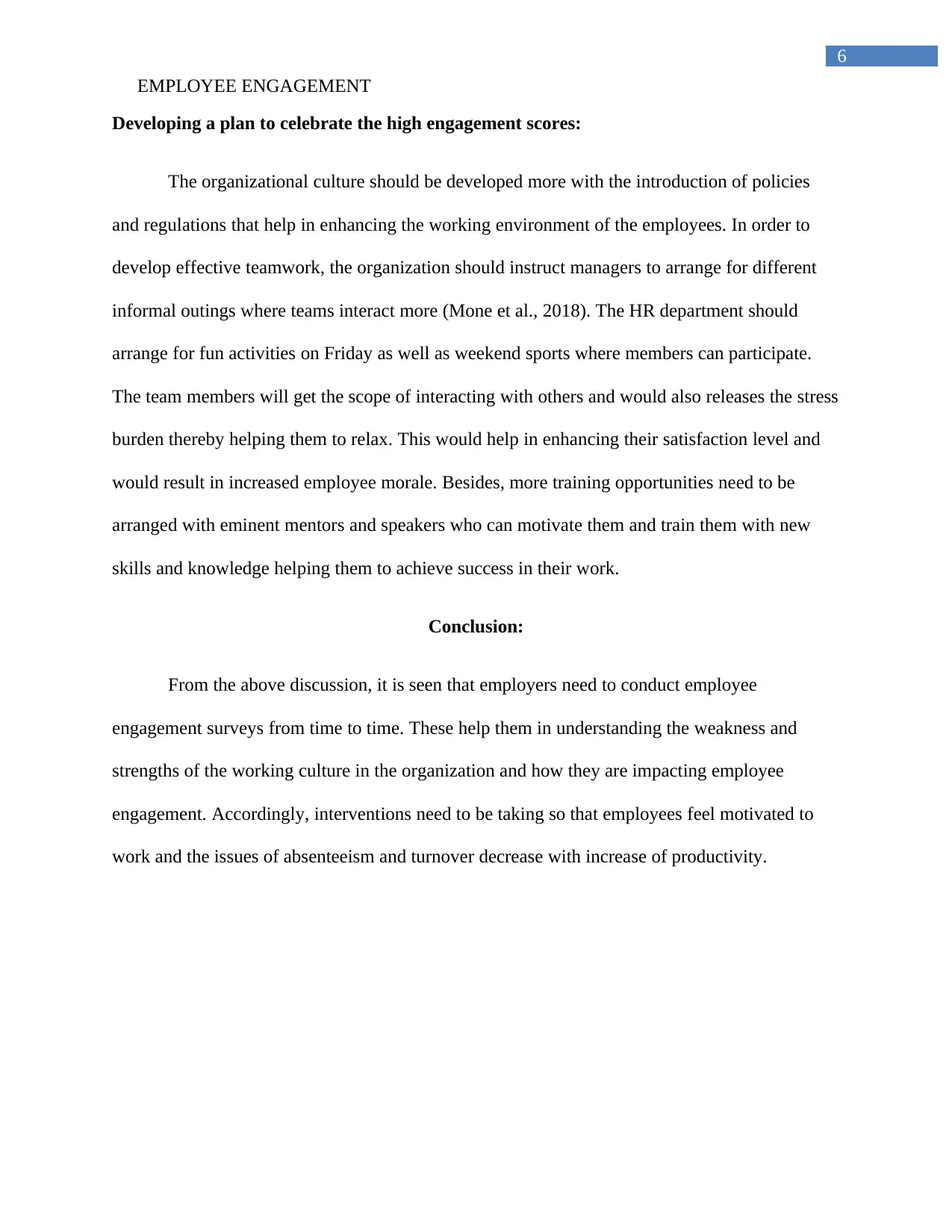
6
EMPLOYEE ENGAGEMENT
Developing a plan to celebrate the high engagement scores:
The organizational culture should be developed more with the introduction of policies
and regulations that help in enhancing the working environment of the employees. In order to
develop effective teamwork, the organization should instruct managers to arrange for different
informal outings where teams interact more (Mone et al., 2018). The HR department should
arrange for fun activities on Friday as well as weekend sports where members can participate.
The team members will get the scope of interacting with others and would also releases the stress
burden thereby helping them to relax. This would help in enhancing their satisfaction level and
would result in increased employee morale. Besides, more training opportunities need to be
arranged with eminent mentors and speakers who can motivate them and train them with new
skills and knowledge helping them to achieve success in their work.
Conclusion:
From the above discussion, it is seen that employers need to conduct employee
engagement surveys from time to time. These help them in understanding the weakness and
strengths of the working culture in the organization and how they are impacting employee
engagement. Accordingly, interventions need to be taking so that employees feel motivated to
work and the issues of absenteeism and turnover decrease with increase of productivity.
EMPLOYEE ENGAGEMENT
Developing a plan to celebrate the high engagement scores:
The organizational culture should be developed more with the introduction of policies
and regulations that help in enhancing the working environment of the employees. In order to
develop effective teamwork, the organization should instruct managers to arrange for different
informal outings where teams interact more (Mone et al., 2018). The HR department should
arrange for fun activities on Friday as well as weekend sports where members can participate.
The team members will get the scope of interacting with others and would also releases the stress
burden thereby helping them to relax. This would help in enhancing their satisfaction level and
would result in increased employee morale. Besides, more training opportunities need to be
arranged with eminent mentors and speakers who can motivate them and train them with new
skills and knowledge helping them to achieve success in their work.
Conclusion:
From the above discussion, it is seen that employers need to conduct employee
engagement surveys from time to time. These help them in understanding the weakness and
strengths of the working culture in the organization and how they are impacting employee
engagement. Accordingly, interventions need to be taking so that employees feel motivated to
work and the issues of absenteeism and turnover decrease with increase of productivity.
Paraphrase This Document
Need a fresh take? Get an instant paraphrase of this document with our AI Paraphraser
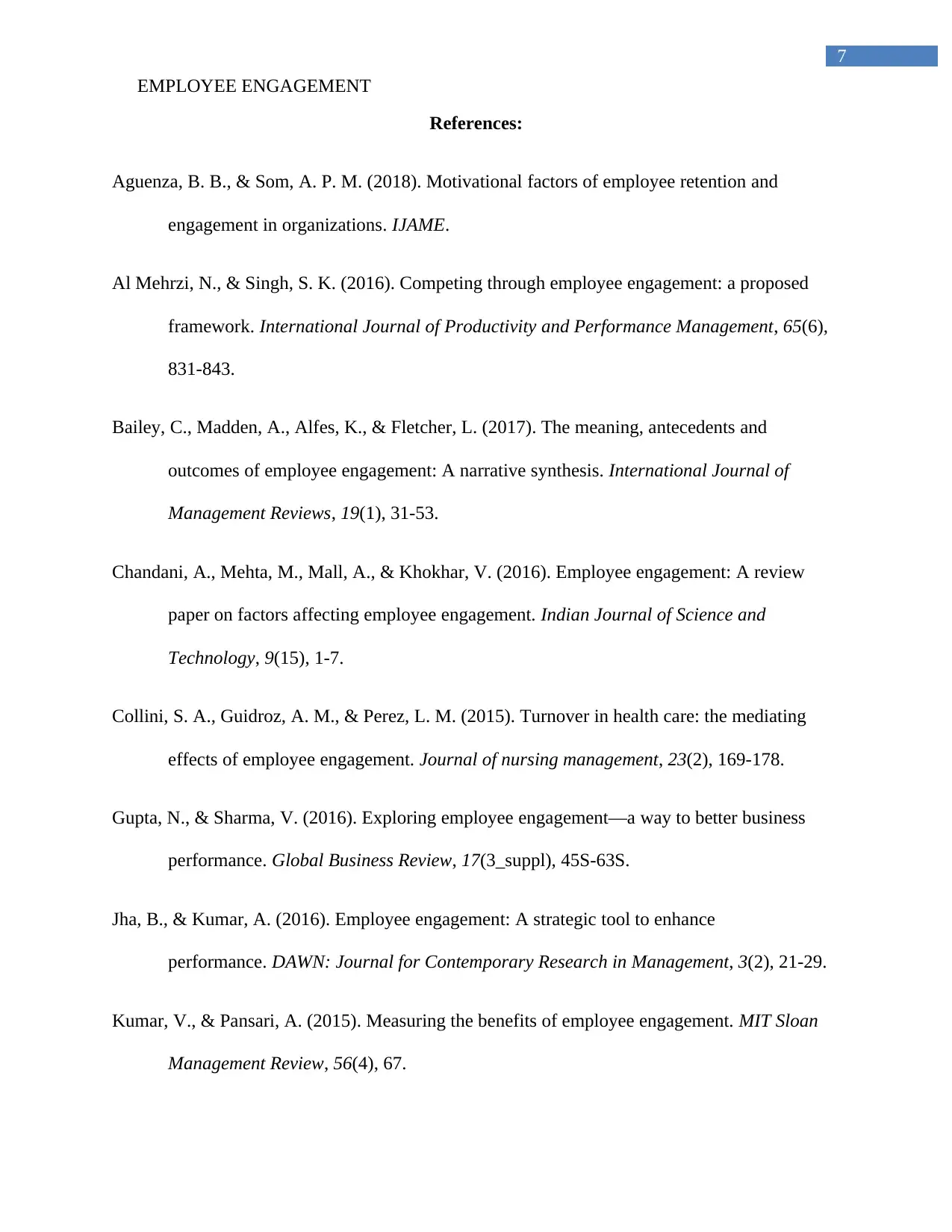
7
EMPLOYEE ENGAGEMENT
References:
Aguenza, B. B., & Som, A. P. M. (2018). Motivational factors of employee retention and
engagement in organizations. IJAME.
Al Mehrzi, N., & Singh, S. K. (2016). Competing through employee engagement: a proposed
framework. International Journal of Productivity and Performance Management, 65(6),
831-843.
Bailey, C., Madden, A., Alfes, K., & Fletcher, L. (2017). The meaning, antecedents and
outcomes of employee engagement: A narrative synthesis. International Journal of
Management Reviews, 19(1), 31-53.
Chandani, A., Mehta, M., Mall, A., & Khokhar, V. (2016). Employee engagement: A review
paper on factors affecting employee engagement. Indian Journal of Science and
Technology, 9(15), 1-7.
Collini, S. A., Guidroz, A. M., & Perez, L. M. (2015). Turnover in health care: the mediating
effects of employee engagement. Journal of nursing management, 23(2), 169-178.
Gupta, N., & Sharma, V. (2016). Exploring employee engagement—a way to better business
performance. Global Business Review, 17(3_suppl), 45S-63S.
Jha, B., & Kumar, A. (2016). Employee engagement: A strategic tool to enhance
performance. DAWN: Journal for Contemporary Research in Management, 3(2), 21-29.
Kumar, V., & Pansari, A. (2015). Measuring the benefits of employee engagement. MIT Sloan
Management Review, 56(4), 67.
EMPLOYEE ENGAGEMENT
References:
Aguenza, B. B., & Som, A. P. M. (2018). Motivational factors of employee retention and
engagement in organizations. IJAME.
Al Mehrzi, N., & Singh, S. K. (2016). Competing through employee engagement: a proposed
framework. International Journal of Productivity and Performance Management, 65(6),
831-843.
Bailey, C., Madden, A., Alfes, K., & Fletcher, L. (2017). The meaning, antecedents and
outcomes of employee engagement: A narrative synthesis. International Journal of
Management Reviews, 19(1), 31-53.
Chandani, A., Mehta, M., Mall, A., & Khokhar, V. (2016). Employee engagement: A review
paper on factors affecting employee engagement. Indian Journal of Science and
Technology, 9(15), 1-7.
Collini, S. A., Guidroz, A. M., & Perez, L. M. (2015). Turnover in health care: the mediating
effects of employee engagement. Journal of nursing management, 23(2), 169-178.
Gupta, N., & Sharma, V. (2016). Exploring employee engagement—a way to better business
performance. Global Business Review, 17(3_suppl), 45S-63S.
Jha, B., & Kumar, A. (2016). Employee engagement: A strategic tool to enhance
performance. DAWN: Journal for Contemporary Research in Management, 3(2), 21-29.
Kumar, V., & Pansari, A. (2015). Measuring the benefits of employee engagement. MIT Sloan
Management Review, 56(4), 67.
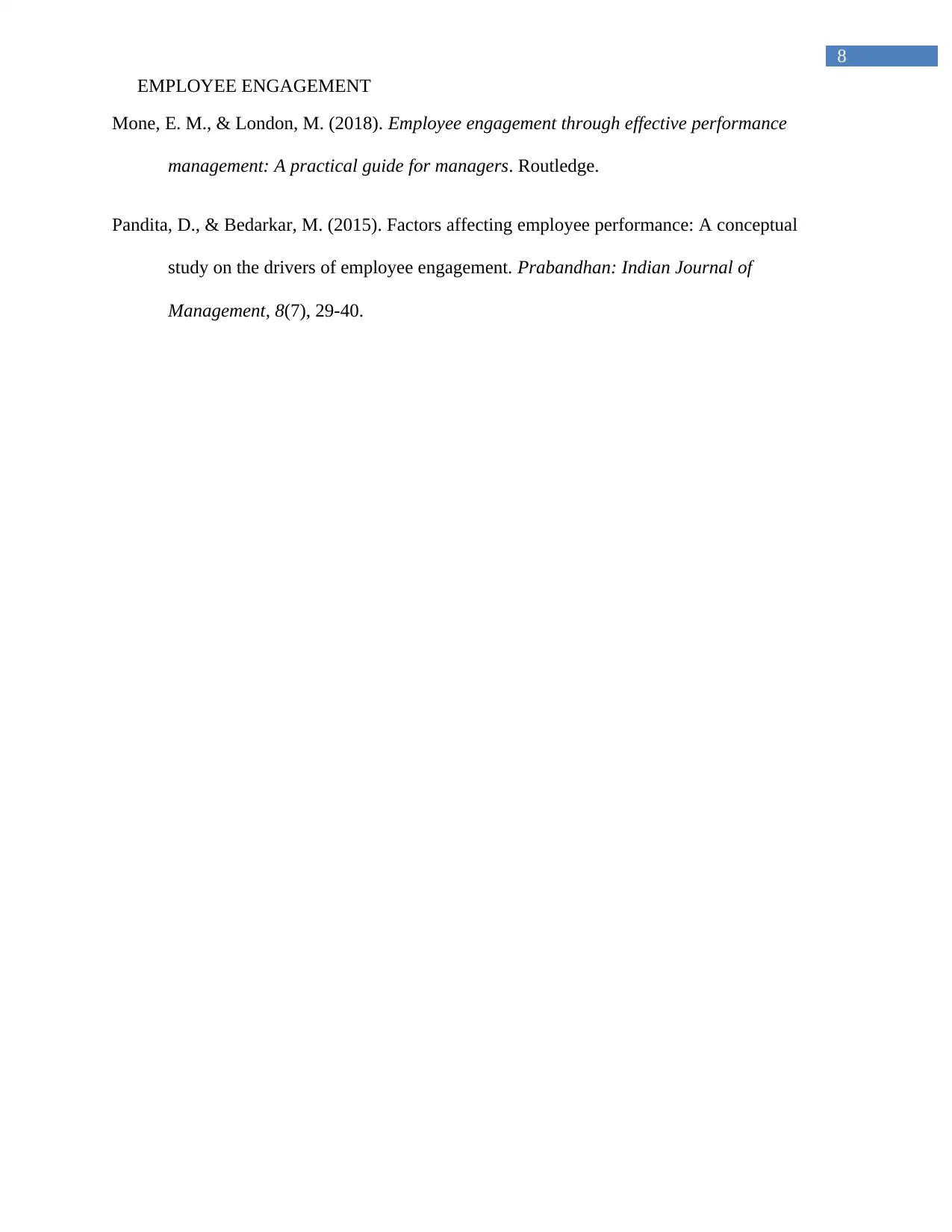
8
EMPLOYEE ENGAGEMENT
Mone, E. M., & London, M. (2018). Employee engagement through effective performance
management: A practical guide for managers. Routledge.
Pandita, D., & Bedarkar, M. (2015). Factors affecting employee performance: A conceptual
study on the drivers of employee engagement. Prabandhan: Indian Journal of
Management, 8(7), 29-40.
EMPLOYEE ENGAGEMENT
Mone, E. M., & London, M. (2018). Employee engagement through effective performance
management: A practical guide for managers. Routledge.
Pandita, D., & Bedarkar, M. (2015). Factors affecting employee performance: A conceptual
study on the drivers of employee engagement. Prabandhan: Indian Journal of
Management, 8(7), 29-40.
1 out of 9
Related Documents
Your All-in-One AI-Powered Toolkit for Academic Success.
+13062052269
info@desklib.com
Available 24*7 on WhatsApp / Email
![[object Object]](/_next/static/media/star-bottom.7253800d.svg)
Unlock your academic potential
© 2024 | Zucol Services PVT LTD | All rights reserved.





